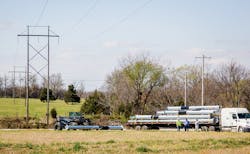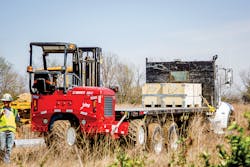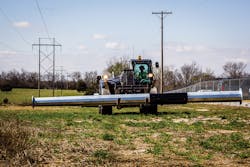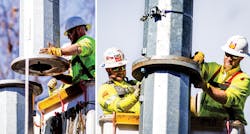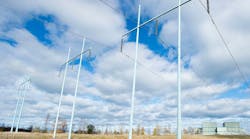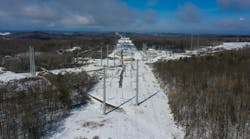Every electric utility experiences its share of disasters. Some of these disasters are minor incidents while others are major events, but both can result in the replacement of thousands of utility poles depending on the severity of the event. The design of most utility poles has not changed in decades. Empire District Electric Co. in Joplin, Missouri, U.S., was no exception.
After historic ice storms, an EF5 tornado and subsequent pole replacements prompted North American Electric Reliability Corporation (NERC) compliance, Empire reexamined its pole design and assembly process. The consensus within the construction and engineering groups was there had to be a better way to get the job accomplished without adding unnecessary expense to the project.
In addition, the team wanted to improve outage durations, lessen environmental impacts and save money as lines were constructed. Also, NERC’s FAC-008 replacements standard loomed in the distance. Not enough time, money or manpower was available for all these measures. Empire — once a small utility in the heart of the Midwest but now part of Liberty Utilities Co. — was facing a perfect storm.
The Process
By helping the utility’s vendors manage risk, the team believed it would help to reduce Empire’s cost, so it set out to design a system that would do this. It was simply built on feedback from select relationships developed in the industry. Feedback obtained and developed through each storm and construction project encountered for more than a decade provided the basis for the development of Empire’s process.
Unlike most utilities, Empire had realized savings by working with the same contractors and consultants for several years. A simple savings was realized by using the same crews and working with them on a time rate. These savings were the result of the crews’ efficiency.
Crews began to realize contributed efficiencies reinforced their contributions to Empire and perpetuated future presence at Empire. Empire realized a consistent savings by working with these same crews. Open and frank conversations from the crews about common issues and suggested improvement were the start of this team approach. These contributions began to shape Empire’s process.
Other team members included engineering, line construction, heavy equipment construction, drilling, right-of-way, material supplies and steel manufacturing. All facets important to the process of building transmission lines were included. Each member could contribute to the efficiencies of the process based on their portion of the project. Everyone continued to shape the process throughout the development.
The Materials
Once the project was identified, engineers made preliminary projections about what materials were needed for the project. This information was loaded into a workflow. Each party involved in Empire’s process — from engineers to construction crews ¾ had access to phones, tablets or computers to view, update and make changes to the project. These updates contributed significantly to the nimble process developed. Small and large obstacles — from manufacturing to construction issues — all can be seen and managed by every team member. Issues were quickly overcome by suggestions from the team members.
Congestion in the Midwest transmission system often can delay or deny outages. Obstacles encountered at construction sites can delay a project even further. These obstacles can increase the risk of a project and are managed by expensive change orders.
In Empire’s new process, these potential delays were mitigated quickly as other portions of the project were ready for construction to proceed. The estimated supply list was sent immediately to the materials supplier. An order for all materials — including steel, the longest lead item — was submitted. To navigate the perfect storm, Empire had to order early, before it had all the answers.
The Pole Design
Transmission poles vary in length to meet terrain variations found along the right-of-way. This requires production of multiple-length component parts to be used for each structure location. This new pole design approach incorporated several improvements over the old method. The upper section of the H-frame, or two-pole tangent structure, was constant. It had the same dimensions and strength characteristics, while the bottom section varied in dimensions and load-bearing characteristics to achieve the required heights. This enabled the supplier to begin building poles before the final details were completed. Like a large Tinkertoy set, structures were modified to the final design when constructed. The standardized design was used throughout the Empire system, with minimum margin but extremely adaptable. The same components could be assembled into a three-pole running corner structure for small angles or a dead-end structure for large angles.
With this design, Empire could stock one pole that took care of all its 69-kV and 161-kV H-frame-type construction. The materials groups could see large cost savings. As a result, Empire could navigate through the perfect storm.
The poles were made from steel, which enabled them to be separated into component sections. The shorter section length enabled easier transport to the project site, better access to project locations and mobility over various terrains. Lastly, the new design enabled crews to make alternations on-site to adapt to the various geographic areas. A common delay during construction prior to the new poles was the need for different size structures. These delays resulted in added cost and materials, and they typically were managed with change orders that quickly increased the job cost. Navigating through the perfect storm, Empire used components readily available to make the final adjustments for construction.
Empire’s process drastically reduced these delays and prevented additional costs. Many features were included in the poles and structure design, which enabled pole manufacturers to order the materials efficiently and cost effectively, and build the pole structures quickly. Several unique features provided construction time savings. Structure bases could be installed prior to the line outage, which reduced the outage time and improved reliability of the system during the construction process. The structure could be installed with an energized line, thereby increasing reliability for heavily congested sections of the transmission grid. In addition, these structures were easy for suppliers to build, and easy and efficient for construction crews to construct.
Team Work
As the supplier was working on the materials list, the land team began communicating with property owners before construction started. The land team further arranged for gate and drop site locations with landowner input. By making agreements with customers on the right-of-way, access issues were resolved ahead time, which enabled crews to work uninterrupted.
It also significantly improved construction productivity. The land team communicated this information back to the engineering department and up-to-date maps were developed. Construction details that included drop site locations and how the site would be accessed were available through these maps for road building, gate installations and material delivery drop sites.
Supply Kits
The supplier prepackaged the materials needed for each structure into a complete kit. These kits were labeled in the factory and delivered in easy-to-move boxes directly to each structure site by the supplier. Construction crews then could move from site to site with no material delays. Extra materials commonly needed to overcome construction issues were included periodically. These extra kits were replenished and modified as needed, with resupplying input from the construction crews.
Previously, material was delivered to one location and construction crews moved the materials in place with their own resources. With the new method, line crews could go from working location to working location and all the materials they needed were at that location. This process enabled the crews to replace up to three structures per day, as opposed to one per day using the old method.
After completion of the project, material pickup and site cleanup was completed as agreed with the customer. Land agents continued to communicate with the landowners throughout the process. This communication not only improved construction efficiency, but it also improved the customer experience. In addition, Empire found it often improved future storm response times because of better landowner relations.
This process, the Empire pole innovative construction (EPiC) platform, resulted in significant cost reductions. EPiC also reduced lengthy outages because structure bases were installed under energized lines. From pole design to workflow, the EPiC platform was a systematic change in pole replacement, resulting in significant savings, environmental improvement and increased structure integrity — not just for Empire but for the industry. ♦
John Donaldson works for Liberty Utilities, where he is responsible for business development for the central region. He holds a BS degree in engineering from the University of Arkansas and is a registered professional engineer in the state of Missouri. Donaldson is a member of the National Society of Professional Engineers and Southwest Missouri’s Area Utility Forum. His efforts in process improvements have been recognized by EEI, as Empire’s EPiC program was honored as a 2016 Edison Award finalist.

